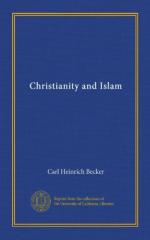Mary the sister of Ahron—an obvious confusion with the Old Testament Miriam—had been devoted to the service of God by her mother’s vow, and lives in the temple under the guardianship of Zacharias, to whom a later heir is born in answer to his prayers, namely John, the forerunner of the Holy Ghost. The birth is announced to Mary and she brings forth Jesus under a palm-tree, near which is a running spring and by the dates of which she is fed. On her return home she is received with reproaches by her family but merely points in reply to the new-born babe, who suddenly speaks from his cradle, asserting that he is the prophet of God. Afterwards Jesus performs all kinds of miracles, forms birds out of clay and makes them fly, heals the blind and lepers, raises the dead, etc., and even brings down from heaven a table ready spread. The Jews will not believe him, but the youth follow him. He is not killed, but translated to God. Christians are not agreed upon the manner of his death and the Jews have invented the story of the Crucifixion.
Muhammed’s knowledge of Christianity thus consists of certain isolated details, partly apocryphal, partly canonical, together with a hazy idea of the fundamental dogmas. Thus the influence of Christianity upon him was entirely indirect. The Muhammedan movement at its outset was influenced not by the real Christianity of the time but by a Christianity which Muhammed criticised in certain details and forced into harmony with his preconceived ideas. His imagination was profoundly impressed by the existence of Christianity as a revealed religion with a founder of its own. Certain features of Christianity and of Judaism, prayer, purification, solemn festivals, scriptures, prophets and so forth were regarded by him as essential to any religious community, because they happened to belong both to Judaism and to Christianity. He therefore adopted or wished to adopt these institutions.
During the period of his life at Medina, Muhammed abandoned his original idea of preaching the doctrines which Moses and Jesus had proclaimed. This new development was the outcome of a struggle with Judaism following upon an unsuccessful attempt at compromise. In point of fact Judaism and Christianity were as widely different from one another as they were from his own teaching and he was more than ever inclined to regard as his special forerunner, Abraham, who had preceded both Moses and Jesus, and was revered by both religions as the man of God. He then brought Abraham into connection with the ancient Meccan Ka’ba worship: the Ka’ba or die was a sacred stone edifice, in one corner of which the “black stone” had been built in: this stone was an object of reverence to the ancient Arabs, as it still is to the Muhammedans. Thus Islam gradually assumed the form of an Arab religion, developing universalist tendencies in the ultimate course of events. Muhammed, therefore, as he was the last in the ranks of the prophets, must also be the greatest. He epitomised all prophecy and Islam superseded every revealed religion of earlier date.




